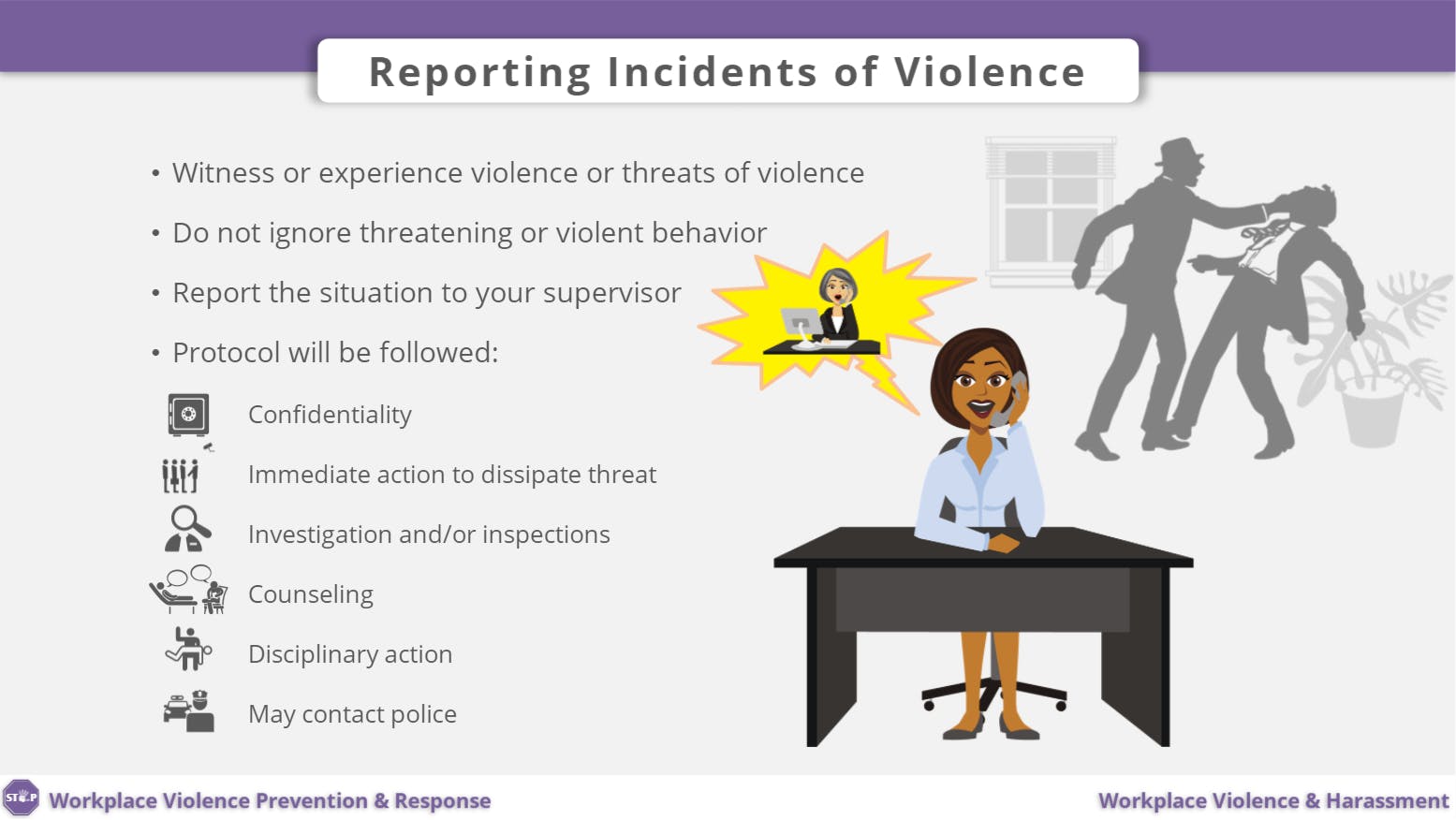Comprehending Legal Needs for California Workplace Violence Prevention Programs
Comprehending Legal Needs for California Workplace Violence Prevention Programs
Blog Article
The Role of Employee Training and Awareness in Enhancing Workplace Physical Violence Avoidance Initiatives Throughout Numerous Industries
The assimilation of staff member training and understanding into work environment violence prevention initiatives is increasingly recognized as a basic facet of organizational safety across varied markets. By applying targeted training programs, services can efficiently encourage their labor force to recognize and attend to potential threats prior to they escalate. The effectiveness of these campaigns typically hinges on a number of crucial elements that differ by sector, raising vital questions concerning the adaptability of training methods and their real-world effect. Understanding these subtleties might reveal strategies that can significantly improve safety methods and employee self-confidence in high-risk atmospheres.
Significance of Training Programs
In today's dynamic workplace, the value of training programs can not be overemphasized, particularly in the context of workplace violence prevention. These programs function as a foundational aspect in growing a protected and risk-free work environment culture. By equipping employees with the knowledge and skills necessary to identify, mitigate, and react to prospective hazards, companies can cultivate a setting that prioritizes security and well-being.
Reliable training programs do greater than just instruct; they encourage staff members to identify caution indications of violence, understand the methods for reporting occurrences, and establish techniques to de-escalate potential problems. Moreover, they impart a sense of collective duty amongst staff, encouraging positive involvement in maintaining a secure work environment.
Financial investment in training not just improves staff member recognition but additionally shows an organization's dedication to securing its workforce. This aggressive strategy can bring about decreased cases of workplace violence, reduced absenteeism, and improved worker spirits. Ultimately, thorough training programs are essential to developing a resistant organizational society that values safety and promotes a healthy and balanced workplace, thus reducing the danger of physical violence and its associated consequences.
Key Parts of Effective Understanding
A detailed understanding program includes a number of essential components that are crucial for effectively avoiding workplace physical violence. Clear interaction of procedures and plans connected to work environment violence is essential. Staff members should be notified about the company's stance on violence and the details procedures in position for reporting incidents.
2nd, training sessions need to incorporate reasonable scenarios that staff members might experience. This useful approach aids staff members identify alerting signs of prospective violence and furnishes them with the necessary abilities to de-escalate tense scenarios. Third, fostering an encouraging workplace society is vital; workers should feel encouraged to speak out without concern of revenge.
Including responses systems enables workers to share their understandings and experiences, which can lead to continual renovation of understanding efforts. By integrating these parts, organizations can create a durable structure for stopping work environment violence, inevitably adding to a more secure and extra effective atmosphere for all employees (california workplace violence prevention).
Industry-Specific Training Approaches
Reliable work environment violence prevention training should be customized to the special difficulties and risks encountered by certain sectors. As an example, health care environments call for training that deals with the high likelihood of experiences with aggressive clients or visitors. Programs should concentrate on de-escalation strategies, acknowledging indication of possible physical violence, and making sure staff recognize the relevance of reporting events.
In comparison, retail settings may encounter different dangers, such as robbery or client disagreements. Training in these environments ought to emphasize situational recognition, response procedures throughout emergency situations, and the significance of safeguarding cash and belongings.
Production and construction markets offer their very own risks, often associated with interpersonal disputes or harmful working conditions. Training in these industries ought to include methods for dispute resolution, advertising a society of safety and security, and urging open interaction amongst staff members.
Moreover, company workplaces might call for training focused on protecting against harassment and intimidation, cultivating a considerate work environment society, and carrying out clear coverage systems. Each market should not only recognize its particular vulnerabilities but likewise adapt training products to resonate with the labor force effectively, making sure that staff members really feel equipped and empowered to take care of potential terrible scenarios.
Measuring Educating Efficiency
Reviewing the effect of office physical violence prevention training is essential for making sure that employees are adequately prepared to take care of prospective hazards. Pre- and post-training surveys can assess changes in worker expertise, perspectives, and behaviors concerning office violence.
Additionally, functional analyses, such as role-playing scenarios or simulations, can offer insights into exactly how well staff members Go Here use learned abilities in real-life scenarios. Checking case reports prior to and after training can likewise act as an indicator of efficiency, as a decrease in cases might reflect improved worker readiness.
In addition, feedback from participants ought to be systematically accumulated to recognize locations for improvement in training content and delivery. Conducting follow-up assessments at regular intervals assists endure recognition and enhances training concepts with time - california workplace violence prevention. By using an extensive approach to measuring training performance, organizations can make sure that their office violence avoidance initiatives promote a more secure setting and boost overall worker health
Structure a Culture of Safety And Security

Training plays a crucial function in this cultural shift. Regular, detailed training sessions inform workers about recognizing indication of work environment physical violence and the appropriate reactions. In addition, motivating open interaction allows employees to voice issues without fear of revenge, promoting cumulative responsibility for safety and security.
Furthermore, integrating security into daily procedures guarantees that it becomes a shared value instead of a simple conformity concern. This consists of regular safety drills, updates on policies, and comments systems that involve employees in safety discussions and enhancements.
Ultimately, a robust society of security not only minimizes the dangers of work environment violence yet also improves staff member spirits and performance. By cultivating a setting where safety is a basic priority, companies can develop resistant work environments that support both individual wellness and cumulative success.
Verdict
In final thought, staff member training and awareness are important components in the prevention of workplace violence across various markets. Reliable training programs, tailored to specific sector demands, improve staff members' ability to respond and recognize to prospective risks. By executing extensive recognition strategies and promoting a culture of security, companies can dramatically lower occurrences of office violence and boost general employee morale. Dedication to continuous training and examination makes certain continual effectiveness and adaptability in resolving arising obstacles within the workplace atmosphere.

Routine, detailed training sessions inform workers regarding identifying caution indicators of work environment violence and the suitable actions.In verdict, employee training and recognition are essential components in the avoidance of workplace violence across numerous industries.
Report this page